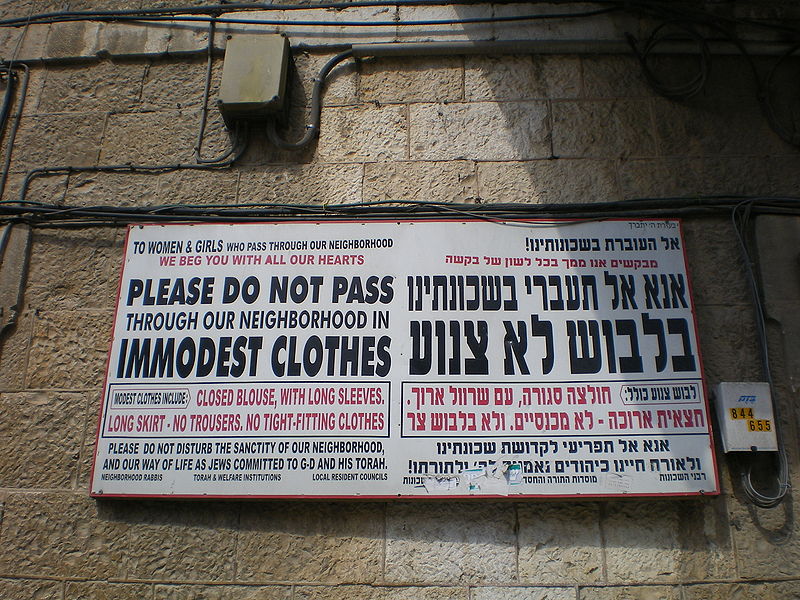Last week, we entered the world of pashkevilim, the distinct posters that that are plastered in Israel’s haredi communities. Today, a look at why have they wield power, and why some people feel that power should be curbed.
Journalist and yeshiva graduate Kobi Arieli explains why pashkevilim have become such a vital part of hareidi culture. “The haredim,” he writes, “are first and foremost an incomparably curious people, inseparably connected to the written word, pure and simple. That’s what pashkevilim are – written words.” “Just as you can’t have a religious community without a shul and a mikveh, so too you can’t have a haredi community without a wall plastered with pashkevilim; if the shul and mikveh express the religious dimension of the place – pashkevilim express the cultural dimension.”
Pashkevilim “make clear what is virtuous or acceptable behaviour and what is not,” explains Samuel C. Heilman. “They serve as expressive media that show what those who prepare and post as well as those who allow the post to be displayed … consider to be acceptable or worthy of notice.”
Just because a poster is on the wall and has the names of several rabbis attached to it, does not mean that it’s genuine. Yoel Krois, (the haredi man who has made pashkevilim accessible to the general public) notes that modern technology has enabled people to create realistic fakes complete with forged signatures of rabbis.
READ: PASHKEVILIM: PEERING INTO POSTERS TO FIND THE SOUL OF A COMMUNITY – PART 1
In Parsing the Posters, Sam Sokol presents some tips on how to tell if an extreme street poster represents the haredi mainstream. This particular case referred to pashkevilim in Bnei Brak which blamed the alleged desecration of graves in Ramla for a barrage of rockets from Gaza. The posters contained no signatures aside from “Gedolei Yisrael”(the Great People of Israel), a previously unknown group, “The Committee for Activities for the Rescue of the Graves of the Mishnaic and Talmudic Sages of Nesher.”
Haredi activist Rabbi Shmuel Pappenheim says the first clue to be aware of is anonymity. The rabbinic leaders of his community “are not afraid to put their names on proclamations” and that “any poster on which the author is afraid to put his name and on which no names of gedolim are written” should not be taken seriously.
Avraham Zuroff, a former haredi journalist, added even if names – and signatures – of haredi leaders are present, the poster’s message may be a distortion of the quoted rabbi’s words. “Many pashkevilim take the words of rabbis out of the context in which they were uttered,” said Zuroff.
Although pashkevilim may be a quaint anachronism for tourists, the same cannot be said for some Israelis who do not share the sentiments they express. In 2015, a group of women in Beit Shemesh was awarded $15,000 in damages from their municipality for the mental and physical anguish they had suffered as a result of the signs. Judge David Gidoni stated that the city’s failure to remove the signs was a violation of women’s civil rights, calling them “hurtful, degrading and discriminatory,” causing “mental distress,” and stating that they “delivered a mortal blow to the rights of women in the city.”
Laura Wharton, a member of Jerusalem City Council, welcomed the ruling. A modesty sign “not only promotes the violence, it legitimizes it,” she told Haaretz. “It says, essentially, that women aren’t allowed here if they don’t have a skirt down to their ankles and implies that they can be attacked if they don’t, which is a vigilante act. … Taking down these signs would send a very strong message to the people who put them up that the law must be enforced.”
Opponents of pashkevilim point to the Torah’s prohibition, “Cursed is he who strikes his fellow in secret.” (Deuteronomy 27:24) Centuries later the Babylonian Talmud (Sukkah 29A) warned against “kotvei plaster,” those who write wall notices.
Rabbi Yaacov Haber is no fan of pashkevilim. “They seldom accomplish anything positive,” he writes, “while they serve the purpose of promoting division and hate amongst Jews.” But Rabbi Haber is a realist and knows that his opinion probably won’t change the minds of pashkevilim producers. So he turned to the words of the widely respected scholar, the Chofetz Chaim, Rabbi Yisrael Meir Kagan (1839-1933).
“I must speak out my heart about the manner of conflict taking place among the Jewish people. One camp publicizes its view with the signatures of all of its backers. The other side does the same. One of them wrote ‘the one with the most signatures wins’, and I say the one with the most signatures is creating unnecessary conflict in Israel. …”
And to make sure his point hits home, Rabbi Haber set the words of the Chofetz Chaim to mimic the form of pashkevilim, in both Hebrew and English.
And Rena Rossner attributes a quote to the Satmar Rabbi, Yoel Teitelbaum, who said (presumably in jest) that the reason why it’s not forbidden by Jewish Law to paste pashkevilim on walls in Jerusalem is because without these placards, the buildings would certainly fall.
